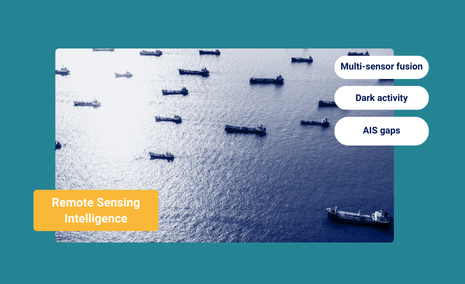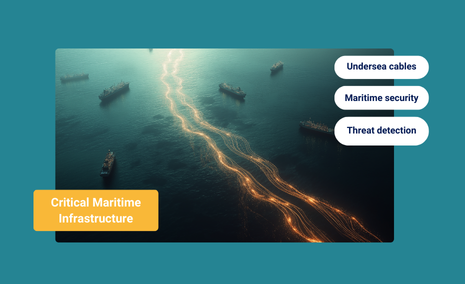Reports
An Unsettling New Reality: The Impact of the Disruptive Environment on Global Trade
The Rubymar – a 172-meter-long Belize-flagged, Lebanese-owned bulk carrier traveling from Saudi Arabia to Bulgaria – sank in the Red Sea on March 2, after being struck by a Houthi missile on February 18. Since the attack, the ship slowly took on water.
The sinking of the Rubymar has emerged as a potent symbol of this escalating maritime crisis, signaling a critical juncture for two key reasons: The Rubymar is the first civilian ship sunk in conflict since the “tanker war” of the 1980s, when Iran and Iraq fired missiles at each others’ merchant vessels.
Not only was the safety of the crew greatly endangered, but significant resources and efforts from the owner and the authorities will be required to tow the vessel to port – previous attempts failed.
Further escalating the situation, the Houthis recorded their first fatalities since they started disrupting passage in the Red Sea. A Houthi missile strike killed three sailors aboard True Confidence in early March and badly burned other crew members, according to U.S. Central Command (CENTCOM).
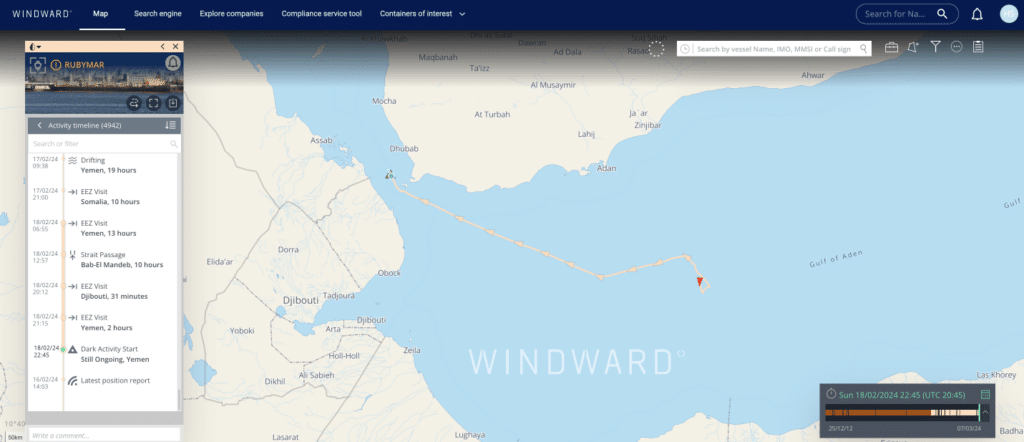
Based on insights from Windward’s Maritime AI™ platform, the attack on the Rubymar occurred when military presence in the Red Sea and the Arabian Sea was at its lowest since September 2023. In January-February 2024, there was a monthly average of 37 visits by military vessels in the area, compared to an average of 86 in September-December 2023 – a 57% drop.
The diluting of military presence in the area since the beginning of 2024 may have contributed to the increase in attacks in the second half of February, culminating in the sinking of the Rubymar.
The second reason lines were crossed concerns the environmental impact. The approximately 21,000 metric tons of ammonium phosphate sulfate fertilizer and the leaking fuel that the Rubymar was carrying present an incredible environmental risk: marine life, including coral reefs, will likely be affected, plus coastal communities that rely on fishing for their livelihoods are extremely concerned.

“An 18-mile oil slick” resulted from the Houthi attack on the Rubymar vessel, according to CENTCOM. An additional national safety risk is the damage done to the communication cable in the area. It was allegedly hit by the Rubymar’s anchor following the strike.
There are three potential reasons for the discrepancy between tankers vs. container ships and bulk carriers:
- Tankers are lighter than container ships and bulk carriers
- Tankers are generally smaller, with mid-sized vessels like Suezmax averaging around 275 meters in length, compared to large container ships, such as the New Panamax at 366 meters
- The Biden administration’s removal of a broad array of sanctions against Venezuela’s oil and gas sector
For a comprehensive analysis of the restricted Panama Canal’s impact on global trade, read our full report.
Some Vessels are Avoiding the Suez and Panama Canals
In the trade lane from China to the North American East Coast, there have been notable route changes. Some vessels are now bypassing the Panama Canal and navigating across the Indian Ocean, sailing around Africa via The Cape of Good Hope. Windward’s Maritime AI™ platform has identified several vessels that traditionally traversed the canal now choosing this alternative route.
For example, the cargo vessel Hyundai Ambition, measuring 366 meters in length, recently embarked from Savannah Port to Shanghai, around The Cape of Good Hope. Below is the current view of the Hyundai Ambition via Windward’s dedicated shipment page, which showcases AI-based predicted ETA.
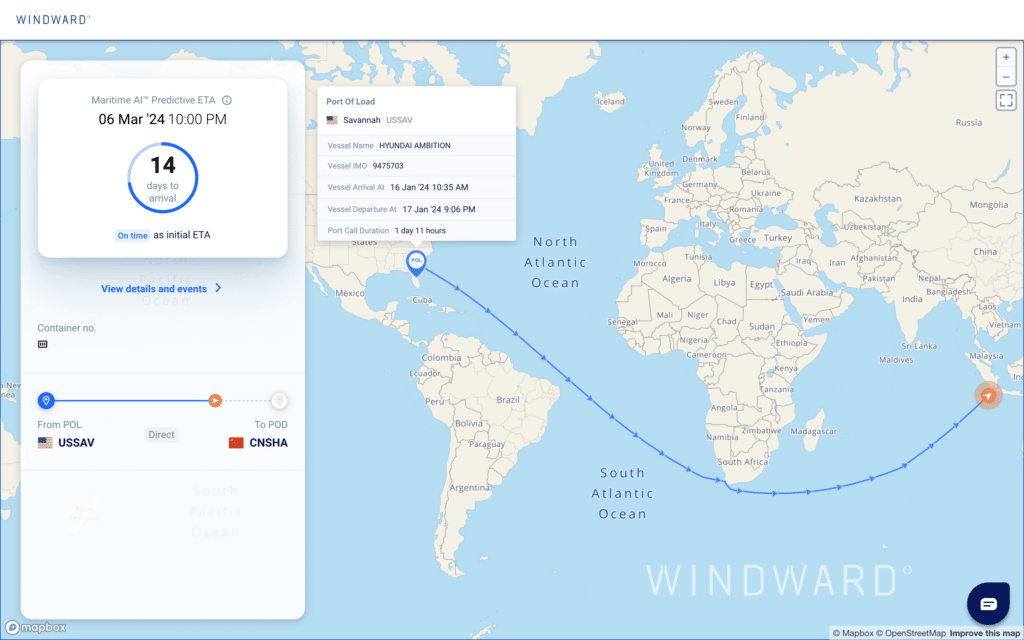
Do you need alerts for route deviations? Learn more.
This instance marks the first time in the past year, according to the platform’s historical patterns capability, that the Hyundai Ambition has navigated this route, having previously passed through the Panama Canal on all six of its documented voyages in 2023-early 2024.
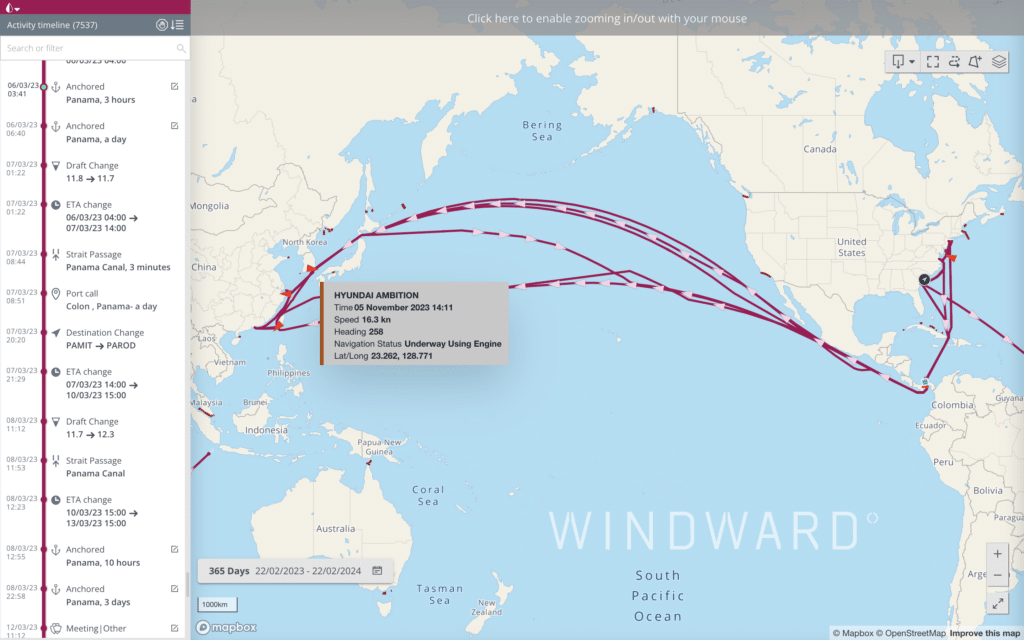
The effect of vessels avoiding both canals are becoming evident in transit times recorded during February. According to the latest edition of Windward Port Insights, the transit time from Asia to the East Coast of the United States has increased.
For instance, during Q4 2023, the average transit time from Asia to New York & Newark, the busiest port on the East Coast, with a monthly TEU capacity of almost a million, was 25.2 days. By February, the average transit time extended to 29.6 days.
This shift is also reflected in container shipping prices; the current cost to ship a container from East Asia to the East Coast of the United States has reached $6,709, marking a 203% increase since October 29.
Interested in a comprehensive overview of the global supply chain? Read Windward Port Insights.
These trends indicate how the drought and resulting restrictions on the Panama Canal are reshaping global trade routes, impacting the efficiency of cargo movement, and potentially leading to a reevaluation of maritime logistics strategies.
More things you should know:
- Transit time from Asia to the UK continues to rise, now nearing almost 30 days.
- Transit time from Asia to key Mediterranean destinations: February saw a significant surge in transit times compared to October, before the Red Sea crisis began:
- Port Said: 30 days (+123%)
- Ashdod: 28.9 days (+61%)
- Piraeus: 25.7 days (+114%)
- Carriers’ ETA vs. Windward Maritime AI™ Predicted ETA: while February marked a notable gap between carriers’ provided ETAs and Windward Maritime AI™ Predicted ETAs, this discrepancy has since narrowed. We anticipate that inaccuracies in carriers’ ETAs will remain frequent.
Without Windward’s AI-based predicted ETA – complemented by comprehensive coverage listing reasons for delay, exceptions and critical event alerts – logistics operators may struggle to navigate under global trade’s existing conditions.
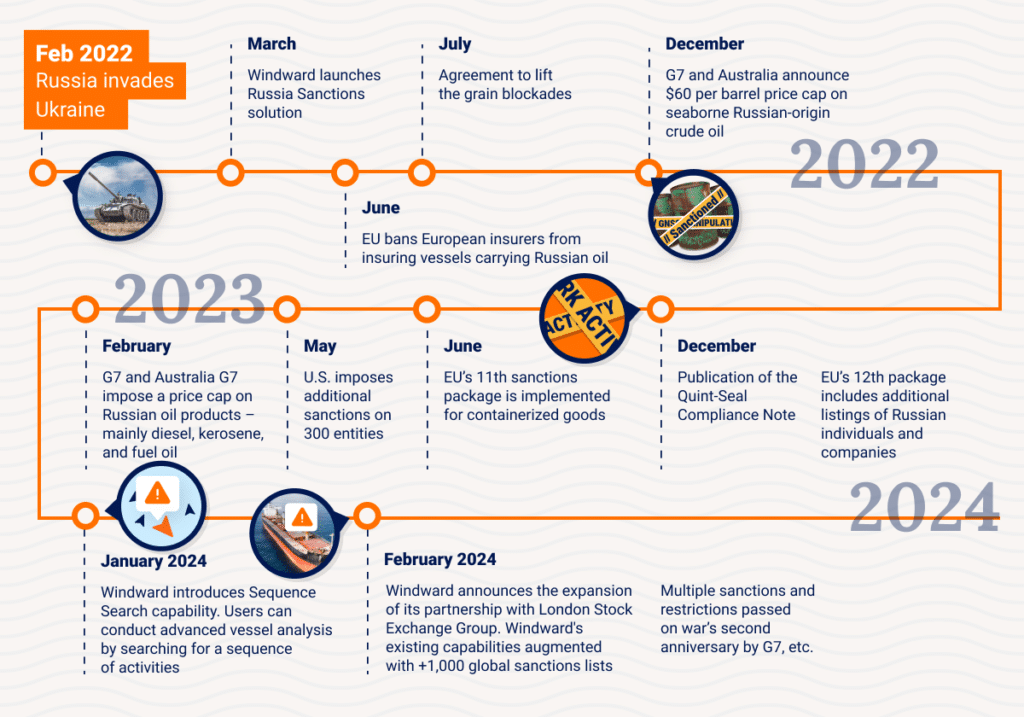
While many sanctions, advisories, and official guidelines were published during the past two years, February 2024 will be remembered as a turning point in the West’s approach to the conflict.
In just one weekend, OFAC, EU, and UK regulators sanctioned over 200 companies and targeted an unprecedented number of 3rd-party countries, such as India, UAE, and Turkey.
While no new price restrictions or trade bans were posed, the extensive focus on 3rd-party stakeholders is a strong testament to the waning patience of Western regulators with sanction evasion techniques.
To quote OFAC’s notice: “Our international coalition is sending a clear message to would-be evaders and circumventers that such actions have and will continue to have consequences”
This increased pressure and closing of loopholes is starting to affect and reshape the shipping ecosystem.
Recognized “flags of convenience” registries are starting to adopt better screening processes to protect their reputation and business from engaging with illicit actors. A recent example of this is Cyprus’ announcement it is launching a new unit to manage sanctions evasions.
This is just one example of a wider trend of illicit actors moving away from the infamous registries – such as Liberia, Panama, and Marshall Islands – for “not yet flagged as risky” registries like Gabon.
Recently, the Sovcomflot fleet was sanctioned as part of the two-year war package. Twelve out of the 14 newly sanctioned vessels were flying the Gabon flag! Windward data shows that all of these vessels changed their flag to Gabon’s from the flag of Panama since 2024’s start.
When we deep dive into the behavioral patterns of these sanctioned vessels by using Windward’s Sequence Search, 13 out of 14 vessels followed the Russia-India oil flow: port call in Russia > port call in India OR dark activity in Russia/Black Sea > port call in India. This trade flow has been an integral part of maintaining Russia’s oil export profits for the past two years.
The fact that so many vessels engaged in this trade flow were sanctioned, along with some Indian-based companies, may be the main cause for India’s unprecedented focus on sanctions enforcement and its announcement that it will continue to buy Russian oil, but at prices under the price cap.
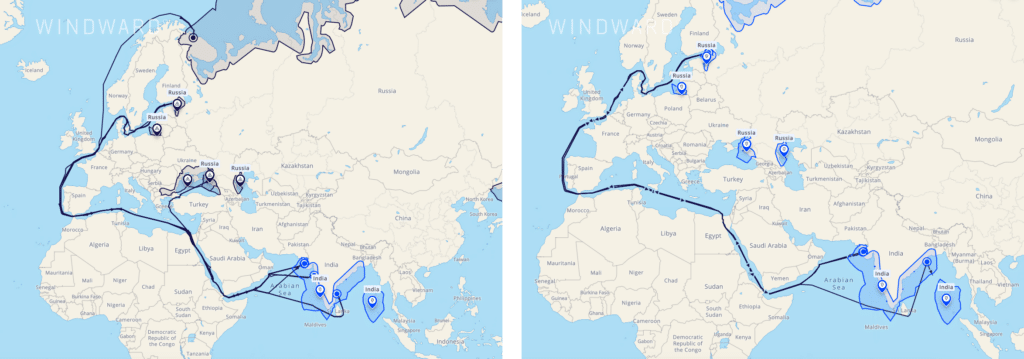
For a comprehensive analysis of the two-year war’s effect on trade flows and deceptive shipping practices, read our full report here.
